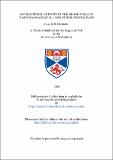Files in this item
Antibacterial activity in the blood cells of 'Carcinas maenas' (L.) and other crustaceans
Item metadata
| dc.contributor.advisor | Smith, Valerie | |
| dc.contributor.author | Chisholm, June R. S. | |
| dc.coverage.spatial | 312 p. | en_US |
| dc.date.accessioned | 2018-07-03T14:47:58Z | |
| dc.date.available | 2018-07-03T14:47:58Z | |
| dc.date.issued | 1993 | |
| dc.identifier.uri | https://hdl.handle.net/10023/14859 | |
| dc.description.abstract | In vitro antibacterial activity in the haemocytes of Carcinus maenas (L) was investigated. Haemocyte lysate supernatants (HLS) were assayed against twelve Gram-positive and Gram-negative marine bacteria, eight of which proved sensitive to the antibacterial factor or factors contained therein. Antibacterial activity was also found in HLS from four other marine crustaceans-Glyptonotus antarcticus, Galathea strigosa, Nephrops norvegicus and Crangon crangon. Activity in C. maenas HLS was independent of divalent cations, operated at high titre, was stable after treatment at 100 °C for 30 minutes and also after three months storage at -70 °C; it was present in the granular cells (which also contain the prophenoloxidase (proPO) activating system, a putative recognition mechanism in arthropods), but was absent from hyaline cells and plasma. In vitro studies were carried out to determine whether a relationship exists between the proPO system and the antibacterial activity in the haemocytes of C. maenas. It was shown that phenoloxidase and an activating serine protease were not responsible for the observed antimicrobial effects, although the possibility that activity resides with some other component of the proPO system has not been excluded. Seasonal variation in antibacterial activity, haemocyte counts and HLS protein concentrations was found, with conspicuous depression of antibacterial activity at two key points in the year. This occurred in conjunction with extremes of water temperature and it is proposed that the variation in antibacterial activity is due to underlying temperature effects on haemocyte counts and protein levels. Low levels of lytic activity against Micrococcus luteus cell walls and low levels of bacterial agglutination were recorded, but the powerful antibacterial activity in HLS could not be attributed to these alone. Gel filtration with Sephadex G-l00 revealed at least three antibacterial proteins of differing molecular size, with estimated MW of 72 kDa, 34 kDa and 4 kDa. The 72 kDa and 34 kDa proteins were bacteriostatic and the 4 kDa protein was bacteriolytic. | en_US |
| dc.language.iso | en | en_US |
| dc.publisher | University of St Andrews | |
| dc.subject.lcc | QL445.2C5 | en |
| dc.subject.lcsh | Crustacea—Physiology | en |
| dc.title | Antibacterial activity in the blood cells of 'Carcinas maenas' (L.) and other crustaceans | en_US |
| dc.type | Thesis | en_US |
| dc.contributor.sponsor | Natural Environment Research Council (NERC) | en_US |
| dc.type.qualificationlevel | Doctoral | en_US |
| dc.type.qualificationname | PhD Doctor of Philosophy | en_US |
| dc.publisher.institution | The University of St Andrews | en_US |
This item appears in the following Collection(s)
Items in the St Andrews Research Repository are protected by copyright, with all rights reserved, unless otherwise indicated.

